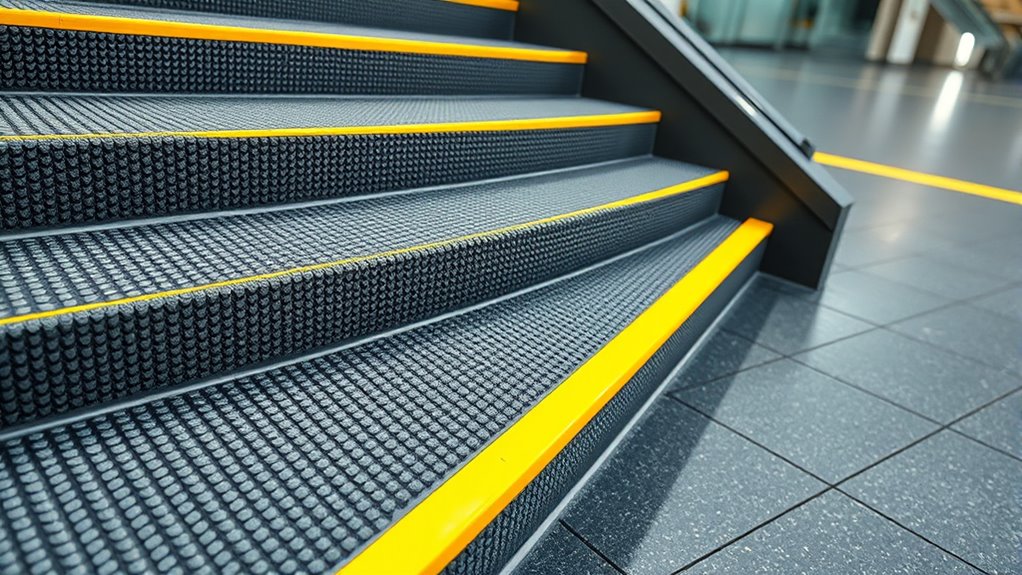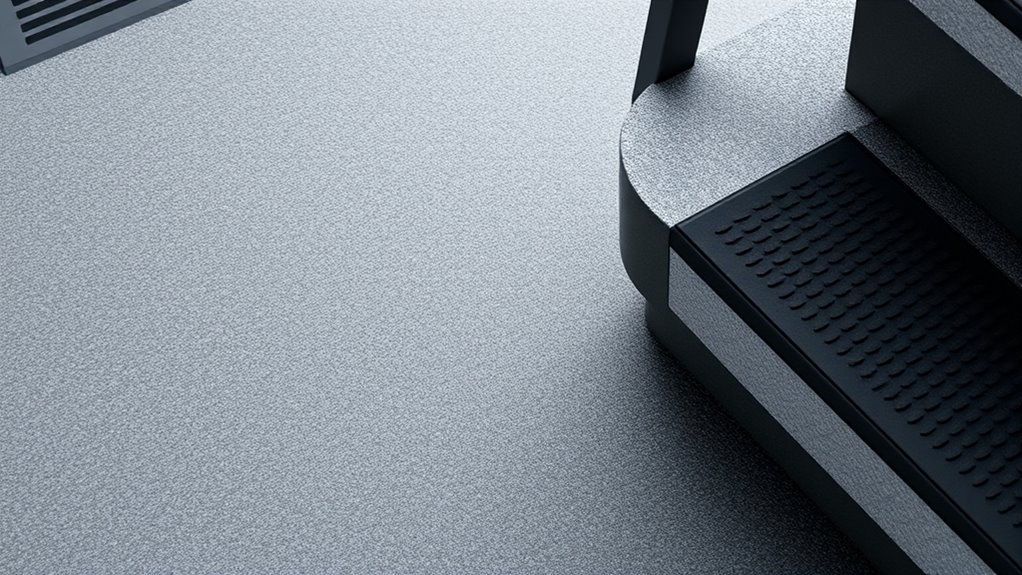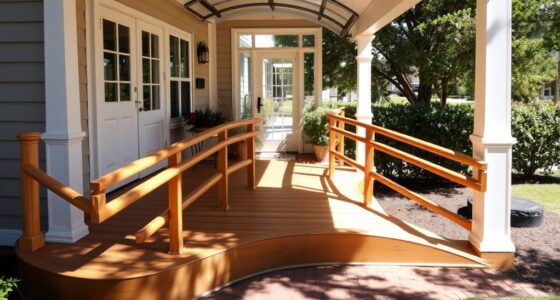To prevent falls, consider installing non-slip flooring options like textured tiles, rubber, or vinyl with anti-slip coatings in high-traffic or moisture-prone areas. Add slip-resistant stair treads or adhesive tapes to existing stairs for quick safety boosts. Regularly clean and maintain these surfaces, and use safety signs or mats where needed. Focusing on slip-resistant materials and proper upkeep can markedly enhance safety—keep exploring to discover more effective solutions.
Key Takeaways
- Select textured or rubber flooring and stair treads with proven slip resistance ratings for optimal safety.
- Install anti-slip coatings or abrasive surfaces on existing floors and stairs for quick safety upgrades.
- Use non-slip rugs and adhesive strips on smooth or wet surfaces to enhance traction.
- Maintain flooring and stair treads regularly by cleaning debris and reapplying anti-slip treatments as needed.
- Incorporate safety signage and conduct routine inspections to ensure ongoing fall prevention measures.

Ensuring safety in both residential and commercial spaces often begins with choosing the right flooring and stair treads. When it comes to preventing slips and falls, slip resistance becomes your top priority. Non-slip flooring surfaces are designed to provide better grip underfoot, especially in areas prone to moisture or spills. By selecting flooring materials with enhanced slip resistance, you markedly reduce the risk of accidents. This safety enhancement is essential for busy kitchens, bathrooms, entryways, and outdoor walkways where slick surfaces are common. When you invest in non-slip options, you’re creating a safer environment for everyone, whether it’s family members, employees, or visitors.
The key to effective safety enhancements lies in understanding the various types of non-slip flooring options available. Textured tiles, rubber flooring, and vinyl with anti-slip coatings offer excellent slip resistance. These materials are engineered to maintain grip even when wet, ensuring that foot traffic remains stable. You should consider the specific needs of each space when choosing flooring—areas with high moisture levels or heavy foot traffic benefit most from textured surfaces or specialized coatings. Installing non-slip stair treads is another essential step in preventing falls on staircases. These treads typically feature abrasive surfaces or embedded slip-resistant materials that provide traction with every step. They’re especially important in commercial buildings, outdoor stairs, or homes with elderly residents who may be more vulnerable to slipping.
Adding safety enhancements like non-slip rugs or adhesive strips can further improve traction on smooth surfaces. For stairs, consider installing stair treads with built-in slip-resistant surfaces or applying anti-slip tape to existing steps. These measures are quick to implement and cost-effective, yet they make a noteworthy difference in safety. When you prioritize slip resistance in your flooring projects, you’re not just choosing a style or durability—you’re actively reducing the likelihood of falls. Regular maintenance, such as cleaning to remove debris and applying anti-slip coatings periodically, keeps these safety features effective over time. Incorporating professional guidance can ensure that the selected safety measures are appropriate and properly installed for optimal protection. Additionally, understanding the materials’ slip resistance ratings can help you make informed decisions tailored to your specific environment. It’s also important to consider necessary cookies and other site features that facilitate maintenance and safety updates. Remember, safety isn’t just about compliance; it’s about protecting everyone who uses your space. Adopting a comprehensive safety plan that includes proper signage and regular inspections further enhances slip prevention measures.
A comprehensive approach to slip resistance includes choosing the right materials, proper installation, and ongoing maintenance to sustain safety standards.
Frequently Asked Questions
How Long Does Non-Slip Flooring Typically Last?
You might wonder how long non-slip flooring lasts. Typically, it has a durability lifespan of 5 to 10 years, depending on usage and maintenance. Regular cleaning helps extend its lifespan, but replacement intervals vary based on foot traffic and wear. If you notice reduced slip resistance or visible damage, it’s time to contemplate replacing the flooring to ensure continued safety and effectiveness.
Can Non-Slip Stair Treads Be Installed Outdoors?
Yes, you can install non-slip stair treads outdoors. Look for options with high outdoor durability and weather resistance to withstand rain, sun, and snow. These treads are specially designed to resist moisture and UV damage, ensuring they stay effective over time. Proper installation and regular maintenance help extend their lifespan, making them a safe choice for outdoor stairs where slip prevention is a priority.
Are Non-Slip Floors Suitable for Wheelchair Accessibility?
Sometimes, the path to better comfort feels just out of reach. Non-slip floors are generally suitable for wheelchair maneuverability, providing safer, more secure footing and reducing slips. They also support accessibility compliance by making spaces easier to navigate for everyone. When installed properly, these floors guarantee smooth shifts and enhance independence, helping you feel confident in your environment while meeting safety standards effortlessly.
What Maintenance Is Required for Non-Slip Surfaces?
You need to regularly maintain non-slip surfaces to guarantee safety. Follow simple cleaning routines, such as sweeping or vacuuming to remove debris, then mop with gentle cleaning solutions to prevent buildup. This helps preserve surface durability and keeps the non-slip properties effective. Avoid harsh chemicals that could damage the finish. Regular upkeep not only maintains traction but also extends the lifespan of your flooring, ensuring it remains safe and durable over time.
Do Non-Slip Flooring Options Affect Indoor Air Quality?
You might worry that non-slip flooring options increase indoor air pollution, but many are designed with low chemical emissions to keep your air clean. While some materials could emit volatile organic compounds (VOCs), modern non-slip surfaces often meet strict safety standards, minimizing chemical emissions. So, choosing eco-friendly options helps maintain healthy indoor air quality, ensuring your home stays safe without sacrificing safety features like slip resistance.
Conclusion
Think of non-slip flooring and stair treads as your home’s loyal shield, quietly guarding you against slips and falls. Just like a sturdy bridge over turbulent waters, they provide a safe passage through daily life’s hazards. By choosing the right anti-slip surfaces, you’re building a fortress of safety that keeps you steady and confident. Don’t wait for a stumble—invest now and let your floors be the unwavering foundation that keeps you moving forward safely.









